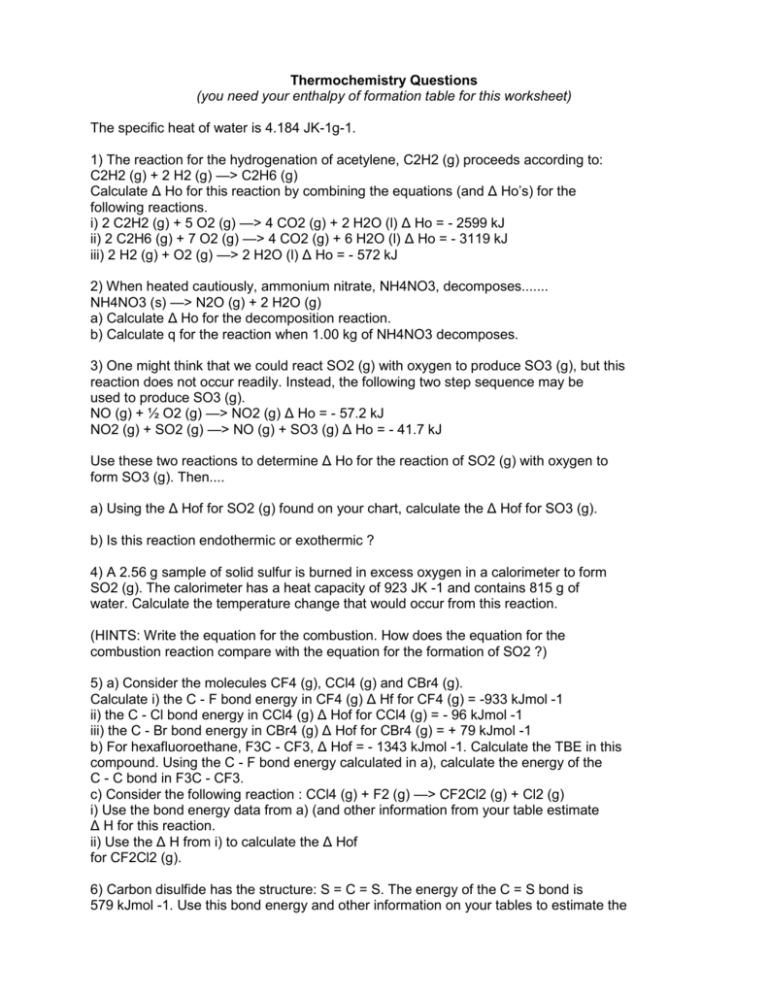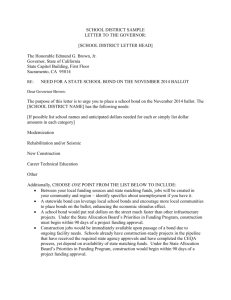Hess`s law and Bond Enthalpy Practice
advertisement

Thermochemistry Questions (you need your enthalpy of formation table for this worksheet) The specific heat of water is 4.184 JK-1g-1. 1) The reaction for the hydrogenation of acetylene, C2H2 (g) proceeds according to: C2H2 (g) + 2 H2 (g) —> C2H6 (g) Calculate Δ Ho for this reaction by combining the equations (and Δ Ho’s) for the following reactions. i) 2 C2H2 (g) + 5 O2 (g) —> 4 CO2 (g) + 2 H2O (l) Δ Ho = - 2599 kJ ii) 2 C2H6 (g) + 7 O2 (g) —> 4 CO2 (g) + 6 H2O (l) Δ Ho = - 3119 kJ iii) 2 H2 (g) + O2 (g) —> 2 H2O (l) Δ Ho = - 572 kJ 2) When heated cautiously, ammonium nitrate, NH4NO3, decomposes....... NH4NO3 (s) —> N2O (g) + 2 H2O (g) a) Calculate Δ Ho for the decomposition reaction. b) Calculate q for the reaction when 1.00 kg of NH4NO3 decomposes. 3) One might think that we could react SO2 (g) with oxygen to produce SO3 (g), but this reaction does not occur readily. Instead, the following two step sequence may be used to produce SO3 (g). NO (g) + ½ O2 (g) —> NO2 (g) Δ Ho = - 57.2 kJ NO2 (g) + SO2 (g) —> NO (g) + SO3 (g) Δ Ho = - 41.7 kJ Use these two reactions to determine Δ Ho for the reaction of SO2 (g) with oxygen to form SO3 (g). Then.... a) Using the Δ Hof for SO2 (g) found on your chart, calculate the Δ Hof for SO3 (g). b) Is this reaction endothermic or exothermic ? 4) A 2.56 g sample of solid sulfur is burned in excess oxygen in a calorimeter to form SO2 (g). The calorimeter has a heat capacity of 923 JK -1 and contains 815 g of water. Calculate the temperature change that would occur from this reaction. (HINTS: Write the equation for the combustion. How does the equation for the combustion reaction compare with the equation for the formation of SO2 ?) 5) a) Consider the molecules CF4 (g), CCl4 (g) and CBr4 (g). Calculate i) the C - F bond energy in CF4 (g) Δ Hf for CF4 (g) = -933 kJmol -1 ii) the C - Cl bond energy in CCl4 (g) Δ Hof for CCl4 (g) = - 96 kJmol -1 iii) the C - Br bond energy in CBr4 (g) Δ Hof for CBr4 (g) = + 79 kJmol -1 b) For hexafluoroethane, F3C - CF3, Δ Hof = - 1343 kJmol -1. Calculate the TBE in this compound. Using the C - F bond energy calculated in a), calculate the energy of the C - C bond in F3C - CF3. c) Consider the following reaction : CCl4 (g) + F2 (g) —> CF2Cl2 (g) + Cl2 (g) i) Use the bond energy data from a) (and other information from your table estimate Δ H for this reaction. ii) Use the Δ H from i) to calculate the Δ Hof for CF2Cl2 (g). 6) Carbon disulfide has the structure: S = C = S. The energy of the C = S bond is 579 kJmol -1. Use this bond energy and other information on your tables to estimate the Δ Hof for CS2 (g). 7) a) Use Δ Hof values to calculate the TBE of ethylene, C2H4 (g). b) The structure of ethylene is H2C = CH2. If the energy of the C - H bond in ethylene is 409 kJmol -1, calculate the energy of the C = C bond in ethylene. 8) a) Use Δ Hof values to calculate the average N - H bond energy in NH3. b) Hydrazine, N2H4 (g) has the structure: HH \/ N-N Δ Hof for N2H4 (g) = + 95.4 kJmol -1 /\ HH Use the value of the N - H bond found in a) to calculate the energy of the N - N bond in hydrazine. Why do you think that this value is so different from the bond energy of gaseous N2 ? c) The energy of the N - F bond is 278 kJmol -1; of the N - Cl bond is 192 kJmol -1. Use these values to calculate the Δ Ho f values for NF3 (g) and NCl3 (g). One of these compounds is explosive and one is stable. Which is which ? 9) In SO2 (g) and SO3 (g), the sulfur to oxygen bonds are double bonds (ie, S = O). Use the Δ Hof values from question 3 to calculate the energy of the S = O bond in each of these compounds. 10) a) Calculate the amount of heat energy required to change 50 g of ice at - 10oC to water at 25oC. (DATA: Specific heat of ice = 2.1 JK -1g-1, Heat of Fusion = 6.0 kJmol -1) b) A mixture of ice and water contains 500 g of ice and 300 g of liquid water at 0oC. Calculate the amount of heat energy required to convert this mixture to 800 g of liquid water at 100oC. (HINT: You must first melt the ice, then heat all the water.) c) 100 g of ice at 0oC are added to 200 g of water at 25oC. What mass of ice will remain when the mixture reaches thermal equilibrium ? (HINT: If both ice and water are present, the temperature of the mixture must be 0oC.) 11) a) Calculate Δ Ho for the conversion of methane into chloroform.... CH4 (g) + 3 Cl2 (g) —> CHCl3 (g) + 3 HCl (g) by combining the following equations: i) ½ H2 (g) + ½ Cl2 (g) —> HCl (g) Δ Ho = - 92.3 kJ ii) C (graphite) + 2 H2 (g) —> CH4 (g) Δ Ho = - 74.5 kJ iii) C (graphite) + ½ H2 (g) + 3/2 Cl2 (g) —> CHCl3 (l) Δ Ho = - 135.1 kJ 12) A 1.50 g sample of benzoic acid, C5H5COOH, was burned in excess oxygen in a calorimeter. The calorimeter had a heat capacity of 893 JK -1 and contained 775 g of water. The initial temperature of the calorimeter and contents was 22.50o C, which rose to 31.69oC at the completion of the combustion. a) Calculate the heat evolved in this combustion reaction. b) Now calculate the molar heat of combustion, in kJmol -1, for benzoic acid.








